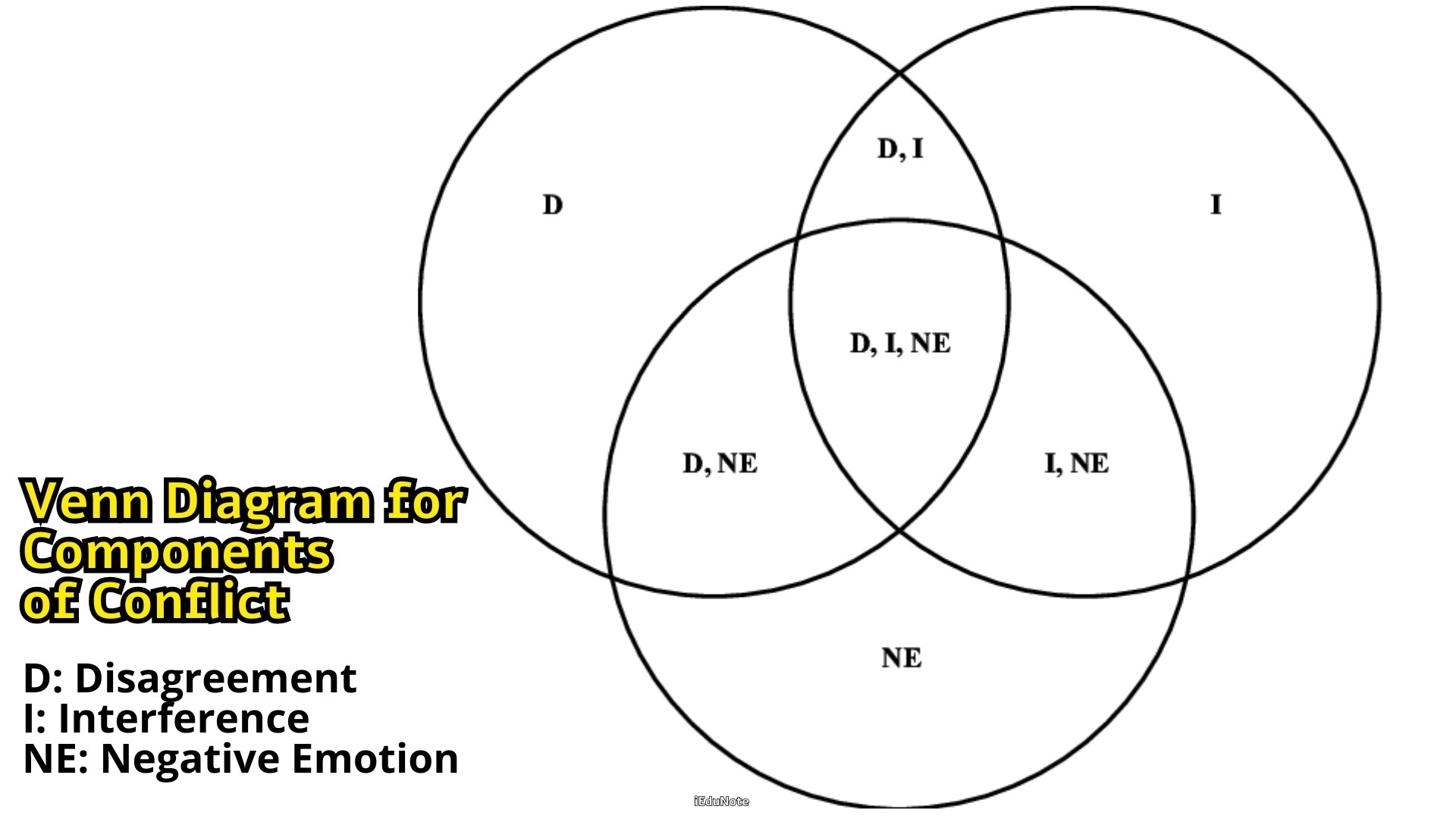The conflict emphasizes three aspects: disagreement, interference, and negative emotion. It corresponds to three components of conflict: cognitive, behavioral, and affective.
Conflict can be equated with the presence of disagreement. It is the most frequently occurring issue in a workplace scenario. Disagreement exists when parties think that a divergence of values, needs, interests, opinions, goals, or objectives exists.
It corresponds to the cognitive aspect of conflict. Secondly, conflict highlights behavioral aspects, such as debate, arguments, competition, political maneuvering, backstabbing, aggression, hostility, and destruction.
While such behaviors may be typical of conflict, they do not always imply the existence of conflict. It is only when the behaviors of one party interfere with or oppose another party’s attainment of its own interests, objectives, or goals that conflict is said to exist.
3 Components of Conflict
Interference
Conflict is perceived as interference, a process in which one party perceives that its interests are being opposed or negatively affected by another party.”
While a number of affective states have been associated with conflict, overwhelmingly, it has been negative emotions such as fear, jealousy, anger, anxiety, and frustration that have been used to characterize conflict.
Negative Emotion
The presence of any one of the three properties (pure disagreement, pure interference, or pure negative emotion) is not sufficient to label a situation as conflictual.
For example, pure disagreement occurs when there are opinion differences concerning goals, tasks, or activities. It may not be accompanied by any interference or negative emotion (as in the case of pure disagreement). Just because people disagree does not mean that they are in conflict.
An example of pure interference would be a situation where the behavior or action of one individual unintentionally prevents another from attaining his or her goals, perhaps by sheer coincidence. Such involuntary, accidental acts of interference would not generally be seen or labeled as conflict.
Finally, organizations are replete with instances of pure negative emotions. Often, individuals dislike or hate others without necessarily disagreeing or interfering with them. Their negative emotions could stem from others’ personal or physical attributes, their choice of friends and associates, or their past behaviors.
Disagreement
Intuitively, the above examples provide instances of pure disagreement, pure interference behavior, and pure negative emotion that would not generally be labeled as conflict.
However, it is important to note that such situations may not be the norm in organizational life. More often than not, disagreement, interference, and negative emotions are likely to occur together.
Conflict can be defined from multiple perspectives. Conflict does not exclusively refer to its antecedent conditions or individual awareness of it, certain affective states, or its overt manifestations or residues of feeling but to all of these taken together. Most reviews of the conflict domain suggest that conflict should be defined using multiple themes or properties.
Interpersonal conflict is defined as a dynamic process that occurs between interdependent parties as they experience negative emotional reactions to perceived disagreements and interference with the attainment of their goals. According to this definition, interpersonal conflict exists only when all three components (i.e., disagreement, interference, and negative emotion) are present.
Conflict as disagreement, negative emotion, or interference

The diagram shows that one group of definitions equates conflict with a single property or theme.
That is, they define interpersonal conflict or a type of interpersonal conflict solely as disagreement (shown in Figure by the disagreement circle), solely as interference (shown in Figure by the interference circle), or solely as negative emotion (shown in Figure by the negative emotion circle).
For example, Dahrendorf (1958) equated conflict with the presence of disagreement: “All relations between sets of individuals that involve an incompatible difference of objective … are in this sense relations of social conflict.” (1958: 135).
More recently, researchers have identified task conflict (or cognitive conflict, Amason, 1996) as one type of conflict and defined it as “… awareness on the part of the parties involved of discrepancies, incompatible wishes, or irreconcilable desires.” (Jehn & Mannix, 2001: 238).
While task conflicts are thought to be at times filled with negative emotions (Jehn, 1997), definitions and measures of this construct have essentially focused on perceived disagreements between the parties involved regarding what tasks need to be done in accomplishing the work assigned to individuals and groups.
Process conflict is also centered on disagreements about the tasks to be done, albeit about “… how task accomplishment will proceed” (Jehn & Mannix, 2001: 239). Thus, the defining property of both constructs is the concept of disagreement.
Conclusion
To summarize, an episode of conflict can be understood by analyzing the needs, perceptions, power, values, feelings, emotions, and behaviors of the people who are party to the conflict.